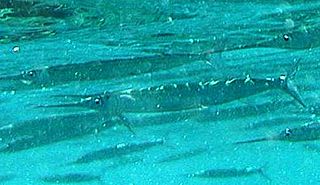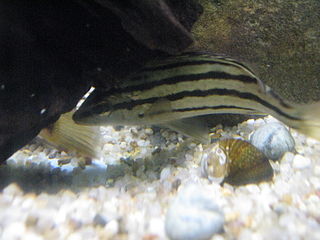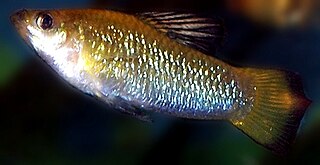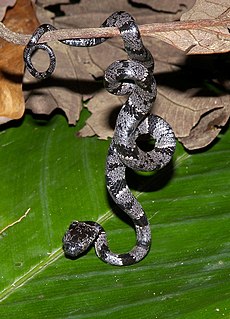
Spiny lizards is the common name for the genus Sceloporus in the family Phrynosomatidae. This genus includes some of the most commonly seen lizards in the United States.

The Microhylidae, commonly known as narrow-mouthed frogs, are a geographically widespread family of frogs. The 584 species are in 61 genera and 11 subfamilies, which is the largest number of genera of any frog family.

Hemiramphus is a genus of schooling marine fish commonly called halfbeaks, garfish, or ballyhoos, and are members of the family Hemiramphidae. They inhabit the surface of warm temperate and tropical sea, and feed on algae, plankton, and smaller fish. Hemiramphus species are edible but are more important as food fish for larger predatory species including dolphinfish and billfish.

Grunters or tigerperches are fishes in the family Terapontidae. Most are found in shallow coastal waters in the Indian Ocean and western Pacific, where they live in saltwater, brackish and freshwater habitats, but there are also true freshwater species found far from the coast. They grow up to 80 cm in length and feed on fishes and invertebrates.

Exocoetus is a genus of flying fishes. It is a bony fish. The body is covered with cycloid scales. The mouth is wide, and the jaws bear teeth. It is a marine fish. The tail has hypobatic fins as the ventral lobe.

Leptodeira is a genus of colubrid snakes commonly referred to as cat-eyed snakes. The genus consists of 12 species that are native to primarily Mexico and Central America, but range as far north as the southern tip of Texas in United States and as far south as Argentina in South America.
Elapsoidea is a genus of venomous elapid snakes commonly known as venomous garter snakes or African garter snakes. Despite the common names, they are unrelated to the harmless North American garter snake species.

Limia is a genus of livebearing fishes belonging to the Cyprinodontiform family Poeciliidae, which includes other livebearers such as platys, swordtails, guppies and mollies. They are found in fresh and brackish water. Of the 21 described Limia species, 17 are endemic to Hispaniola, one is found on both Hispaniola and Jamaica, and the Cayman Islands, Cuba, and Venezuela have an endemic species each. Limia are popular in aquaria among more advanced hobbyists.

Cypselurus is a genus of flying fish in the family Exocoetidae.

Cheilopogon is a genus of flyingfishes.

Hyperolius is a large genus of frogs in the family Hyperoliidae from Sub-Saharan Africa.

Characodon is a genus of splitfins endemic to north–central Mexico. Two of the species are highly threatened and restricted to pools, ponds and springs in the upper San Pedro Mezquital River basin in Durango. The third species, C. garmani, was restricted to springs near Parras in Coahuila, but it became extinct when they dried out.

Pachypanchax is a genus of aplocheilid killifishes native to freshwater in Madagascar, with one species known from Seychelles.

Poeciliopsis is a genus of poeciliid fishes that primarily are native to Mexico and Central America. The only exceptions are P. turrubarensis where the range extends into Colombia, and P. occidentalis where the range extends into Arizona and New Mexico.
Luciobarbus is a genus of ray-finned fishes in the family Cyprinidae. Its members are found in fresh and brackish waters of southern Europe, northern Africa, the wider Near East, the Aral and Caspian Seas, and rivers associated with these. Several species in the genus are threatened. Most species are fairly small to medium-sized cyprinids, but the genus also includes several members that can surpass 1 m (3.3 ft) in length and the largest, the mangar can reach 2.3 m (7.5 ft).

Hyporhamphus is a genus of halfbeaks.

Profundulus is a genus of fish in the family Profundulidae endemic to Mexico and northern Central America.
Floridichthys is a genus of pupfishes native to the southeastern United States, Mexico and northern Central America.

Sibon is a genus of snakes found in northern South America, Central America and Mexico.

Philothamnus is a genus of snakes in the family Colubridae. The genus is endemic to Sub-Saharan Africa.



















